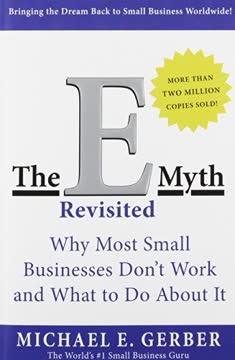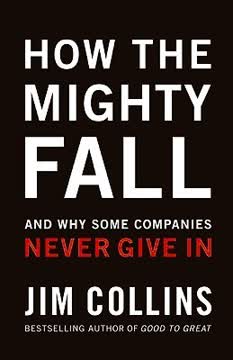Key Takeaways
1. Build the company, not just the product
The company itself is the ultimate creation.
Clock building, not time telling. Visionary companies focus on building enduring institutions rather than relying on a single great idea or charismatic leader. They create organizational structures, processes, and cultures that can thrive beyond any individual product or person. This approach allows for continual innovation and adaptation over time.
Examples:
- Hewlett-Packard: Focused on creating an innovative engineering environment rather than a single product
- Walt Disney: Built a company that could continue producing magic long after Walt's death
- 3M: Developed a culture of innovation that consistently produces new products across diverse industries
2. Preserve the core ideology while stimulating progress
Core ideology provides the bonding glue that holds an organization together as it grows, decentralizes, diversifies, expands globally, and attains diversity within.
Yin and yang of visionary companies. Successful organizations maintain a delicate balance between preserving their fundamental purpose and values (core ideology) while constantly adapting and evolving their strategies, practices, and goals. This duality allows them to remain true to their essence while embracing change and growth.
Key components:
- Core ideology: Enduring purpose and values that remain constant
- Drive for progress: Relentless push for change, improvement, and growth
- Operational practices: Constantly evolving strategies, products, and methods
3. Set Big Hairy Audacious Goals (BHAGs) to drive progress
A true BHAG is clear and compelling and serves as a unifying focal point of effort—often creating immense team spirit.
Ambitious targets inspire action. BHAGs are long-term, ambitious objectives that galvanize an entire organization. They provide a clear direction and energize employees, pushing the company to achieve extraordinary results.
Characteristics of effective BHAGs:
- Clear and compelling
- Long-term (10-30 years)
- Challenging but achievable
- Aligned with core ideology
Examples:
- Boeing's commitment to the 747 jumbo jet
- NASA's goal to put a man on the moon
- Walmart's aim to become a $125 billion company by 2000
4. Cultivate a cult-like culture aligned with core values
Visionary companies tend to be more demanding of their people than other companies, both in terms of performance and congruence with the ideology.
Strong culture, strong performance. Visionary companies develop intense, ideologically-driven cultures that attract like-minded individuals and repel those who don't fit. This creates a highly committed workforce aligned with the company's core values and purpose.
Cultural elements:
- Rigorous employee selection and indoctrination
- Clear boundaries between insiders and outsiders
- Sense of elitism and belonging to something special
- Consistent reinforcement of core values
Examples:
- Nordstrom's fanatical customer service culture
- Disney's emphasis on "wholesome" entertainment
- Johnson & Johnson's Credo guiding decision-making
5. Embrace "Try a lot of stuff and keep what works" mentality
Visionary companies make some of their best moves by experimentation, trial and error, opportunism, and—quite literally—accident.
Evolutionary progress through variation and selection. Successful companies encourage widespread experimentation and quickly capitalize on unexpected opportunities. They create an environment that allows for multiple "mutations" and then select and amplify the most successful ones.
Key practices:
- Decentralized structure allowing for local innovation
- Tolerance for mistakes and failed experiments
- Rapid recognition and scaling of successful ideas
- Balance between planned strategies and opportunistic moves
Examples:
- 3M's "15% rule" allowing employees to work on personal projects
- Johnson & Johnson's accidental discovery of Band-Aids
- Sony's evolution from rice cooker to electronics giant
6. Develop and promote leaders from within
Home-grown management rules at the visionary companies to a far greater degree than at the comparison companies (by a factor of six).
Continuity of leadership. Visionary companies prioritize developing and promoting internal talent rather than bringing in outside CEOs. This ensures continuity of the core ideology and allows for smooth leadership transitions.
Benefits of home-grown management:
- Deep understanding of company culture and values
- Long-term perspective on company success
- Preservation of core ideology across generations
Examples:
- General Electric's rigorous succession planning process
- Procter & Gamble's tradition of promoting from within
- IBM's history of internal CEO selections
7. Foster a relentless drive for self-improvement
Visionary companies display a remarkable ability to achieve even their most audacious goals.
Good enough never is. Successful companies cultivate a perpetual dissatisfaction with the status quo, constantly pushing themselves to improve and innovate. They create mechanisms to stimulate progress and prevent complacency.
Self-improvement strategies:
- Setting stretch goals and raising standards
- Investing heavily in research and development
- Encouraging continuous learning and skill development
- Implementing rigorous performance measurement and feedback systems
Examples:
- Motorola's pursuit of Six Sigma quality standards
- Hewlett-Packard's commitment to continuous innovation
- Walmart's relentless focus on lowering costs and improving efficiency
8. Maintain consistent alignment between ideology and actions
Keep in mind that there is a big difference between being an organization with a vision statement and becoming a truly visionary organization.
Walk the talk. Visionary companies ensure that their actions, decisions, and operational practices consistently align with their stated core ideology. This alignment creates authenticity and reinforces the company's values throughout the organization.
Alignment practices:
- Translating core values into concrete policies and procedures
- Making key decisions based on ideological fit rather than short-term gain
- Regularly assessing and eliminating misalignments
- Communicating ideology through multiple channels and touchpoints
Examples:
- Merck's decision to develop and give away a cure for river blindness
- Southwest Airlines' commitment to employee satisfaction as a path to customer satisfaction
- Patagonia's environmental activism aligning with its core purpose
Last updated:
FAQ
What's Built to Last about?
- Visionary Companies: Built to Last examines the traits and habits of companies that have achieved long-term success, contrasting them with less successful counterparts.
- Research-Based Insights: Authors James C. Collins and Jerry I. Porras conducted a six-year study of companies founded before 1950 to identify factors contributing to enduring success.
- Core Ideology and Progress: The book highlights the importance of a strong core ideology and the need for continuous innovation and progress.
Why should I read Built to Last?
- Timeless Principles: The book offers management principles that transcend business trends, making it relevant for anyone interested in sustainable success.
- Inspiration for Leaders: It serves as a guide for CEOs, managers, and entrepreneurs, providing practical advice on building visionary organizations.
- Real-World Examples: Case studies from successful companies like Disney and Procter & Gamble illustrate the book's concepts, making them relatable and actionable.
What are the key takeaways of Built to Last?
- Core Ideology is Essential: Visionary companies have a core ideology that includes values and a purpose beyond profit, guiding their actions.
- Embrace Change and Progress: Companies must preserve their core ideology while stimulating progress through bold goals and experimentation.
- Cult-Like Cultures: Strong, cult-like cultures reinforce core values and create a sense of belonging among employees.
What is the concept of "core ideology" in Built to Last?
- Definition of Core Ideology: It consists of core values and a purpose that guide a company’s actions, remaining relatively fixed over time.
- Importance of Authenticity: Core ideology should reflect genuine beliefs, not superficial statements designed to please stakeholders.
- Guiding Force: It serves as a guiding force for employees, helping them navigate challenges and maintain focus on the company’s vision.
How do visionary companies stimulate progress according to Built to Last?
- Big Hairy Audacious Goals (BHAGs): Visionary companies set bold, clear goals that inspire employees and create urgency.
- Experimentation and Evolution: They encourage a culture of experimentation, allowing employees to try new ideas and learn from failures.
- Alignment with Core Ideology: Progress is pursued in a way that aligns with the company’s core ideology, ensuring new initiatives support the mission.
What is the "Tyranny of the OR" and the "Genius of the AND" in Built to Last?
- Tyranny of the OR: This mindset forces a choice between two opposing ideas, like stability OR progress, limiting potential.
- Genius of the AND: Embraces the ability to pursue both extremes simultaneously, like maintaining core values AND pursuing innovation.
- Application in Companies: Visionary companies balance core ideology with a drive for progress, thriving on both stability and change.
How do cult-like cultures benefit visionary companies in Built to Last?
- Strong Commitment to Ideology: Cult-like cultures ensure employees are aligned with the organization’s values and mission.
- Selective Hiring Practices: Rigorous screening ensures new hires fit well with the company’s ideology, maintaining a cohesive workforce.
- Enhanced Performance: Employees in such cultures are more engaged and productive, feeling a strong sense of belonging and purpose.
What role do BHAGs play in a company's success according to Built to Last?
- Clear and Compelling Goals: BHAGs provide a clear target, motivating employees to work towards a shared vision.
- Encouragement of Innovation: The audacity of BHAGs encourages creative thinking and risk-taking, leading to breakthroughs.
- Long-Term Momentum: BHAGs sustain momentum and drive progress, becoming ingrained in the company’s culture.
How do visionary companies manage continuity and change in Built to Last?
- Preserve Core Ideology: They maintain a strong core ideology, providing stability and direction amidst change.
- Adaptable Practices: Willingness to change operational practices while keeping core values intact.
- Ongoing Learning: Fostering a culture of continuous learning and improvement, allowing evolution without losing foundational principles.
How does Built to Last define a visionary company?
- Enduring Success: Visionary companies achieve long-term success and maintain a strong market position over decades.
- Core Ideology and Progress: They have a clear core ideology and actively stimulate progress through innovation and adaptation.
- Home-Grown Leadership: Promoting leaders from within ensures continuity and alignment with core ideology.
What are the common traits of visionary companies according to Built to Last?
- Strong Core Ideology: A well-defined set of core values and purpose guides operations and decision-making.
- Commitment to Innovation: Willingness to take risks and encourage experimentation for achieving goals.
- Long-Term Focus: Investing in future growth over short-term profits, making sacrifices today for greater rewards later.
How can I apply the lessons from Built to Last in my organization?
- Define Core Ideology: Articulate your organization’s core values and purpose, engaging employees in the process.
- Set BHAGs: Establish ambitious, long-term goals that inspire and challenge your team, aligning with core ideology.
- Create Mechanisms for Progress: Implement systems encouraging innovation and continuous improvement, fostering a culture that embraces change.
Review Summary
Built to Last examines visionary companies that have endured over decades. It challenges common myths about successful businesses, emphasizing core values, long-term thinking, and adaptability. The book highlights concepts like "clock building" over "time telling," embracing the "genius of AND," and preserving core ideology while stimulating progress. Many readers find it insightful and applicable to business strategy, though some criticize its research methodology. The book's ideas have influenced corporate culture and leadership approaches, making it a widely referenced work in business literature.
Similar Books










Download PDF
Download EPUB
.epub digital book format is ideal for reading ebooks on phones, tablets, and e-readers.











